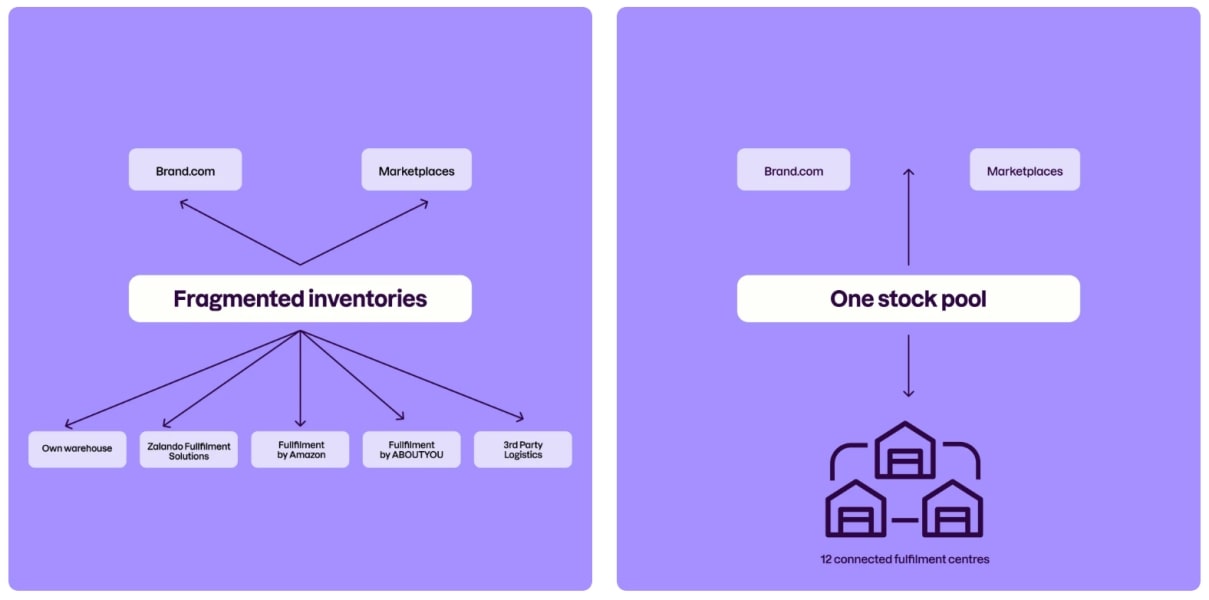Tackling stock splitting challenges for European fashion brands with a One Stock Pool Solution
Written by
Editorial TeamPublished on
Managing inventory across multiple locations can be challenging for European fashion brands, often leading to costly overstock and stockouts. ZEOS’s single-stock pool solution simplifies logistics, boosting efficiency and profitability. (Ad)

Commercial collaboration
Managing inventory across multiple locations presents challenges for fashion brands in Europe. Stock splitting–the practice of dividing inventory into smaller quantities across multiple pools–can lead to both overstock and stockouts, complicating logistics and increasing costs. By consolidating inventory into a single stock pool, ZEOS provides a streamlined approach that improves efficiency and profitability.
Optimising Inventory Management in European Fashion E-Commerce
The European fashion e-commerce market presents immense opportunities but also complex challenges, especially for brands expanding their reach across multiple countries and marketplaces. With a highly fragmented continent, diverse customer preferences, and varied local regulations, managing stock allocation and distribution becomes a core difficulty, especially for brands adopting a direct-to-consumer (DTC) model. However, multi-channel selling often means outsourcing logistics, resulting in inventory being divided among different stock pools by channel and market–called stock splitting. This can create logistical inefficiencies, with too much inventory in one location and not enough in another.
However, recent advances in inventory management strategies suggest that a unified, or “one stock pool”, approach may be a powerful solution for brands to streamline operations, optimise costs, and improve service quality across Europe. Here, we’ll explore the challenges posed by split stocks, the implications of these for fashion brands, and how the concept of a unified stock pool could help address these issues.
Want a snackable overview of the one stock pool concept? Watch this interview with Jan Bartels, Senior Vice President of ZEOS, the multi-channel fulfilment solution from Zalando.
Business Casual is a series of video interviews hosted by Elena Ermishina, Head of Marketing at ZEOS. Here the company unpacks all things e-commerce, logistics, and innovation tailored to fashion & lifestyle.
The Multi-Market Complexity in Europe
Unlike the U.S. or China, which have large, relatively homogeneous markets, Europe is more accurately described as a collection of unique markets. Although the continent holds enormous potential for brands, they must manage regional differences in language, currency, payment preferences, and delivery expectations.
For instance, about 80% of German customers prefer home delivery, while 75% of Polish consumers lean toward picking up their packages from a collection locker. This geographic diversity impacts customer expectations, which in turn shapes the logistics and inventory demands for brands. Complicating matters further, each market has its own leading multi-brand platforms. While pan-European players like Zalando and Amazon dominate in some regions, other countries rely more on local favourites such as Otto in Germany or Allegro in Poland. In addition to managing their own e-commerce channels (i.e. brand.com), brands may need to navigate an intricate multi-market environment across various platforms, catering to both local and cross-border customers.
This multi-market and multi-platform approach creates unique challenges in inventory planning, particularly when stock is divided across numerous warehouses, distribution centres, and third-party logistics (3PL) providers. The result is often an inefficient allocation of stock and a heightened risk of overstocking or stockouts.
The Costly Impact of Split Stocks in Fashion E-commerce
Stock splitting has become a notable challenge for fashion brands, exacerbated by the increasing shift from wholesale to DTC models. As brands have pivoted towards DTC, they’ve gained greater control over pricing and inventory but have also encountered operational complexity. Rather than relying on wholesale partners to manage logistics, brands must now oversee fulfilment themselves, often through third-party logistics providers or marketplace fulfilment models. As a result, inventory is split across numerous pools, increasing the complexity and costs associated with stock management.

When stock is divided into multiple pools, several challenges emerge:
1. Higher storage and transportation costs: Each stock pool requires separate storage, which can quickly add up, especially as brands enter new markets. Additionally, the need to frequently transport products between locations leads to higher logistical costs and complicates route optimisation.
2. Inventory balancing difficulties: Predicting demand accurately across different channels is difficult, especially for fashion brands where trends can shift overnight. This often results in stockouts in high-demand areas and overstock in locations with low demand.
3. Inefficient tracking and inventory errors: Tracking inventory across multiple locations is challenging, leading to increased risk of errors, missed sales opportunities, and excess carrying costs.
4. Increased carbon footprint: Transportation between multiple stock pools results in a larger carbon footprint due to increased emissions, adding a layer of sustainability concerns.
ZEOS and the One Stock Pool Solution
The concept of one stock pool represents a strategic solution to the challenges of split stocks in multi-market e-commerce. Rather than storing inventory in isolated pools across locations and channels, a unified stock pool consolidates inventory within a single, interconnected system that can dynamically allocate stock across multiple markets based on real-time demand.
How ZEOS’s One Stock Pool Solution Works
ZEOS’s One Stock Pool simplifies inventory management by consolidating stock into a unified pool distributed across a network of 12 strategically located fulfilment centres and 20 return centres in Europe. Brands ship their goods to ZEOS’s network, where stock is then centrally managed and digitally connected across all key sales channels, including major European marketplaces and the brands’ own webshops.
Advanced algorithms continuously assess demand patterns to dynamically reallocate stock, ensuring availability where it’s needed most while minimising the risk of overstock and stockouts. Returned items are swiftly reintegrated into the main inventory pool and redistributed as demand dictates, enabling seamless stock management across regions.
By creating a single, agile inventory source, ZEOS’s One Stock Pool supports optimal stock levels and efficient returns processing, ensuring brands can meet customer demand responsively and cost-effectively.
Benefits of One Stock Pool
1. Optimised Inventory Allocation
A single stock pool enables dynamic allocation of inventory based on real-time demand data and predictive algorithms. This flexibility ensures that stock is available where it’s needed most, reducing the likelihood of both overstocking and stockouts.
For example, if sales for a particular style of jeans surge on a specific marketplace, inventory can be reallocated to meet that demand, maximising sales opportunities. Through data-driven insights, brands can make better allocation decisions, minimising the need for reactive measures such as emergency stock transfers.
2. Streamlined Returns Process
Returns management is a significant consideration in fashion e-commerce, where return rates are higher than in other industries. A unified stock pool facilitates a smoother returns process by allowing returns to be reintegrated into a central inventory, regardless of the channel through which the product was sold.
This means that returned items can quickly re-enter the available stock pool, reducing the time and cost associated with refurbishing and re-shipping. Additionally, the faster turnaround of returns into the active inventory helps mitigate the need for discounting slow-moving stock at the end of the season.
3. Reduced Holding Costs
Centralising inventory reduces the need for high-safety stocks at multiple locations, minimising holding costs. When stock is pooled into one centralised network, brands require less overall inventory to ensure the same service level across channels, as they can dynamically allocate based on demand.
For fashion brands, this approach means lower overhead costs associated with warehousing and logistics, which can free up capital for other growth investments. Moreover, with fewer stockpiles scattered across multiple locations, brands are less likely to end the season with unsold goods requiring deep discounts.
4. Enhanced Profitability
By reducing logistical inefficiencies, a unified stock pool can lead to improved profitability. With fewer inventory redundancies, better stock allocation, and more efficient returns management, brands can cut operational costs and focus on revenue-generating activities. Moreover, accurate, real-time data insights can inform smarter replenishment strategies, reducing excess stock and markdowns.
5. Data-Driven Decision Making
A unified stock pool centralises data, providing a holistic view of inventory and customer demand across all channels. With a unified dataset, brands can analyse purchasing patterns, identify demand trends, and make informed decisions regarding production, distribution, and promotions.
This comprehensive insight is particularly valuable in fashion, where trends are highly volatile. Brands can leverage centralised data to adjust their buying, merchandising, and pricing strategies in response to shifting customer preferences.

Key Considerations When Implementing a Unified Stock Pool Strategy
While a unified stock pool offers significant benefits, implementing this approach requires careful planning and execution. Here are some factors brands should consider:
Advanced Technology and Infrastructure
Integrating one stock pool demands advanced logistics technology that can provide real-time inventory visibility and accurate demand forecasting. Brands will need to invest in AI-driven solutions capable of analysing sales data, consumer behaviour, and logistical constraints to make agile decisions about stock allocation.
Robust Fulfilment Network
A unified stock pool is only effective if supported by a reliable, geographically dispersed fulfilment network. For fashion brands selling across Europe, this network should consist of strategically located distribution centres that can reach customers within target delivery windows while maintaining cost efficiency.
Sustainable Practices
With sustainability becoming an increasingly important factor in consumer decision-making, brands must consider the environmental implications of their inventory strategies. A unified stock pool allows for greater control over logistics routes, minimising unnecessary transfers and reducing the carbon footprint of deliveries.
Customer-Centric Focus
Different European markets have varying delivery and payment preferences. A unified stock pool strategy should be designed to accommodate these unique needs. Brands may need to tailor certain aspects of the distribution process to align with local expectations, ensuring that customer satisfaction is not compromised in the pursuit of operational efficiency.
One Stock Pool: A Step Towards Agile Fashion Retail
In a fast-paced industry where customer demands shift rapidly, fashion brands need agile inventory management strategies to stay competitive. A unified stock pool presents an opportunity to overcome the challenges associated with split stocks, allowing brands to deliver products where they’re needed, reduce costs, and enhance profitability. By consolidating inventory into an interconnected, responsive system, brands can achieve a more balanced and efficient approach to stock management, ultimately building resilience in an unpredictable market.
As brands strive to meet the demands of European consumers while balancing the complexities of a fragmented market, the move toward a unified stock pool represents a forward-thinking step. By leveraging this approach, fashion brands can streamline their supply chains, respond to demand fluctuations with greater agility, and position themselves as leaders in an increasingly competitive e-commerce landscape.
***


